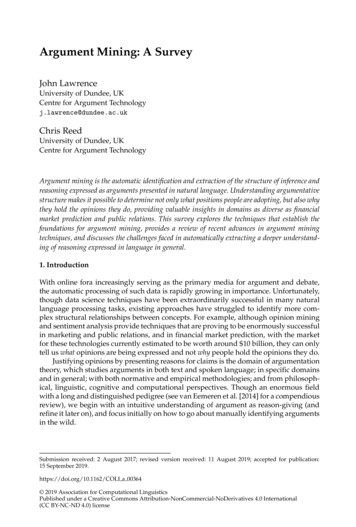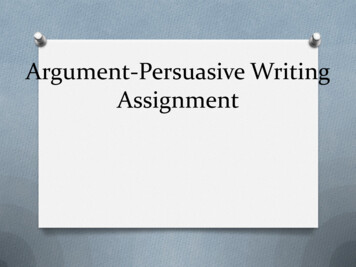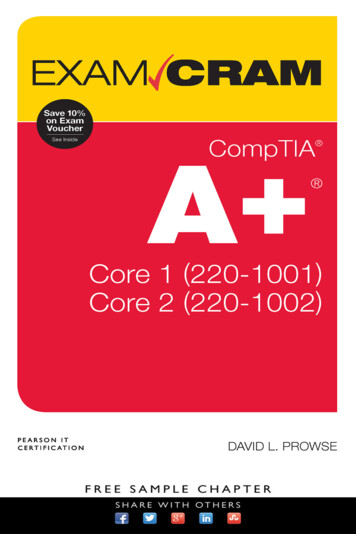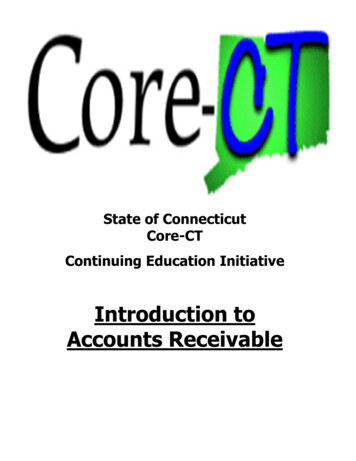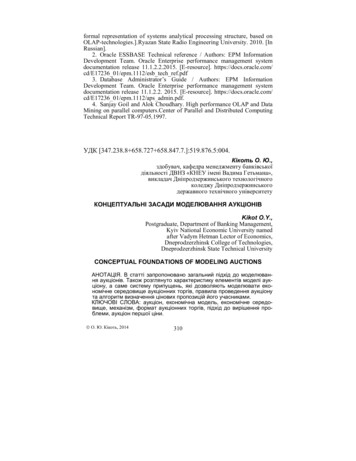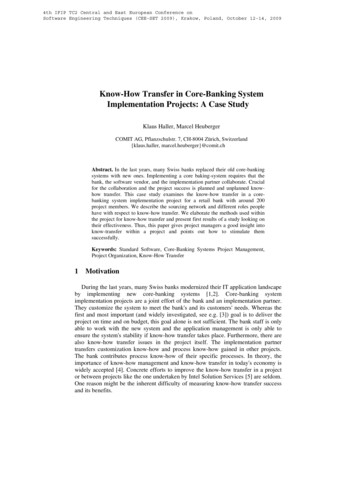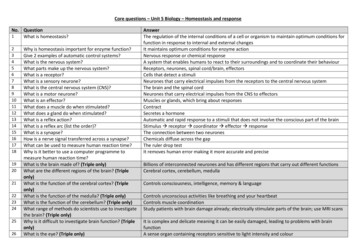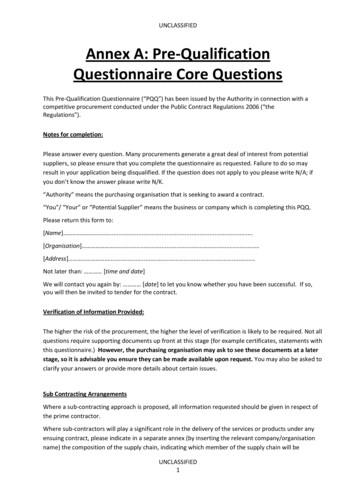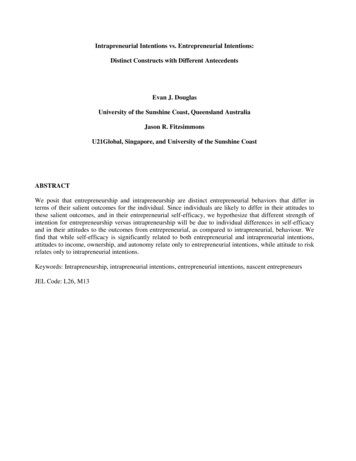
Transcription
The Core of an ArgumentA Claim with ReasonsIn Part One we explained that argument combines truth seeking with persuasion.Part One, by highlighting the importance of exploration and inquiry, emphasizesthe truth-seeking dimension of argument. The suggested writing assignments inPart One included a variety of exploratory tasks: freewriting, playing the believing and doubting game, and writing a formal exploratory essay. In Part Two weshow you how to convert your exploratory ideas into a thesis-governed classicalargument that uses effective reasons and evidence to support its claims. Eachchapter in Part Two focuses on a key skill or idea needed for responsible andeffective persuasion.The Classical Structure of ArgumentClassical argument is patterned after the persuasive speeches of ancient Greekand Roman orators. In traditional Latin terminology, the main parts of a persuasive speech are the exordium, in which the speaker gets the audience's attention;the narratio, which provides needed background; the propositio, which isthe speaker's claim or thesis; the partitio, which forecasts the main parts of thespeech; the confirmatio, which presents the speaker's arguments supportingthe claim; the confutatio, which summarizes and rebuts opposing views; and theperoratio, which concludes the speech by summing up the argument, calling foraction, and leaving a strong, lasting impression. (Of course, you don't need toremember these tongue-twisting Latin terms. We cite them only to assure youthat in writing a classical argument you are joining a time-honored tradition thatlinks back to the origins of democracy.)Let's go over the same territory again using more contemporary terms.We provide an organization plan showing the structure of a classical argument on page 61 , which shows these typical sections: The introduction. Writers of classical argument typically begin with anattention grabber such as a memorable scene, illustrative story, or startling statistic. They continue the introduction by focusing the issue- oftenby stating it directly as a question or by briefly summarizing opposingviews- and providing needed background and context. They concludethe introduction by presenting their claim (thesis statement) and forecasting the argument's structure.60
CHAPTER 3 The Core of an ArgumentOrganization Plan for an Argument with a Classical StructureAttention grabber (often a memorable scene) Exordium Narratio PropositioIntroduction(one toseveral paragraphs)Explanation of issue and needed backgroundWriter's thesis (claim)Forecasting passage PartitioMain body of essay ConjirmatioPresentation of writer'spositionSummary of opposingviews ConjutatioPresents and supports each reason in turnEach reason is tied to a value or belief heldby the audienceSummary of views differing from writer's(should be fair and complete)Refutes or concedes to opposing viewsResponse to opposingviews Shows weaknesses in opposing viewsMay concede to some strengthsBrings essay to closureOften sums up argument PeroratioConclusionLeaves strong last impressionOften calls for action or relates topicto a larger context of issues The presentation of the writer's position. The presentation of the writer's ownposition is usually the longest part of a classical argument. Here writers present thereasons and evidence supporting their claims, typically choosing reasons that tie intotheir audience's values, beliefs, and assumptions. Usually each reason is developed inits own paragraph or sequence of paragraphs. When a paragraph introduces a newreason, writers state the reason directly and then support it with evidence or a chainof ideas. Along the way, writers guide their readers with appropriate transitions. The summary and critique of alternative views. When summarizing and responding to opposing views, writers have several options. If there are several opposing arguments, writers may summarize all of them together and then compose a singleresponse, or they may summarize and respond to each argument in turn. AB we willexplain in Chapter 7, writers may respond to opposing views either by refuting themor by conceding to their strengths and shifting to a different field of values.61
62PART 2Writing an Argument The conclusion. Finally, in their conclusion, writers sum up their argument, oftencalling for some kind of action, thereby creating a sense of closure and leaving astrong final impression.In this organization, the body of a classical argument has two major sections-theone presenting the writer's own position and the other summarizing and critiquing alternative views. The organization plan and our discussion have the writer's own position coming first, but it is possible to reverse that order. (In Chapter 7 we consider thefactors affecting this choice.)For all its strengths, an argument with a classical structure may not alwaysbe your most persuasive strategy. In some cases, you may be more effective by delaying your thesis, by ignoring alternative views altogether, or by showing greatsympathy for opposing views (see Chapter 7). Even in these cases, however, theclassical structure is a useful planning tool. Its call for a thesis statement and aforecasting statement in the introduction helps you see the whole of your argument in miniature. And by requiring you to summarize and consider opposingviews, the classical structure alerts you to the limits of your position and to theneed for further reasons and evidence. As we will show, the classical structure creates is a particularly persuasive mode of argument when you address a neutral orundecided audience.Classical Appeals and the Rhetorical TriangleBesides developing a template or structure for an argument, classical rhetoricians analyzed the ways that effective speeches persuaded their audiences. Theyidentified three kinds of persuasive appeals, which they called logos, ethos, andpathos. These appeals can be understood within a rhetorical context illustratedby a triangle with points labeled message, writer or speaker, and audience (seeFigure 3.1). Effective arguments pay attention to all three points on this rhetoricaltriangle.As Figure 3.1 shows, each point on the triangle corresponds to one of the threepersuasive appeals: Logos (Greek for "word") focuses attention on the quality of the message- that is, onthe internal consistency and clarity of the argument itself and on the logic of its reasonsand support. The impact of logos on an audience is referred to as its logical appeal. Ethos (Greek for "character") focuses attention on the writer's (or speaker's)character as it is projected in the message. It refers to the credibility of thewriter. Ethos is often conveyed through the tone and style of the message,through the care with which the writer considers alternative views, and throughthe writer's investment in his or her claim. In some. cases, it's also a function ofthe writer's reputation for honesty and expertise independent of the message.The impact of ethos on an audience is referred to as its ethical appeal or appealfrom credibility.
CHAPTER 3The Core of an ArgumentMessageLOGOS: How can I make the argumentinternally consistent and logical?How can Ifind the best reasons andsupport them with the best evidence?AudiencePATHOS: How can I make the readeropen to my message? How can I bestappeal to my reader's values andinterests? How can I engage myreader emotionally and imaginatively?Writer or SpeakerETHOS: How can I present myselfeffectively? How can I enhance mycredibility and trustworthiness?FIGURE 3.1 The rhetorical triangle Pathos (Greek for "suffering" or "experience") focuses attention on the values and beliefs of the intended audience. It is often associated with emotional appeal. But pathosappeals more specifically to an audience's imaginative sympathies-their capacity tofeel and see what the writer feels and sees. Thus, when we turn the abstractions oflogical discourse into a tangible and immediate story, we are making a pathetic appeal. Whereas appeals to logos and ethos can further an audience's intellectual assentto our claim, appeals to pathos engage the imagination and feelings, moving the audience to a deeper appreciation of the argument's significance.A related rhetorical concept, connected to the appeals of logos, ethos, and pathos, isthat of kairos, from the Greek word for "right time," "season," or "opportunity." Thisconcept suggests that for an argument to be persuasive, its timing must be effectivelychosen and its tone and structure in right proportion or measure. You may have hadthe experience of composing an argumentative e-mail and then hesitating before clicking the "send" button. Is this the right moment to send this message? Is my audienceready to hear what I'm saying? Would my argument be more effective if I waited for acouple of days? If I send this message now, should I change its tone and content? Thisattentiveness to the unfolding of time is what is meant by kairos. We will return to thisconcept in Chapter 6, when we consider ethos and pathos in more depth.Given this background on the classical appeals, let's tum now to logos-the logicand structure of arguments.63
64PART 2Writing an ArgumentIssue Questions as the Origins of ArgumentAt the heart of any argument is an issue, which we can define as a controversial topicarea such as "the labeling of biotech foods" or "racial profiling," that gives rise to differingpoints of view and conflicting claims. A writer can usually focus an issue by asking an issue question that invites at least two alternative answers. Within any complex issue-forexample, the issue of abortion-there are usually a number of separate issue questions:Should abortions be legal? Should the federal government authorize Medicaid paymentsfor abortions? When does a fetus become a human being (at conception? at threemonths? at quickening? at birth?)? What are the effects of legalizing abortion? (One person might stress that legalized abortion leads to greater freedom for women. Anotherperson might respond that it lessens a society's respect for human life.)Difference between an Issue Questionand an Information QuestionOf course, not all questions are issue questions that can be answered reasonably in two ormore differing ways; thus not all questions can lead to effective arguments. Rhetoricianshave traditionally distinguished between explication, which is writing that sets out to informor explain, and argumentation, which sets out to change a reader's mind. On the surface, atleast, this seems like a useful distinction. If a reader is interested in a writer's questionmainly to gain new knowledge about a subject, then the writer's essay could be consideredexplication rather than argument. According to this view, the following questions aboutteenage pregnancy might be called information questions rather than issue questions:How does the teenage pregnancy rate in the United States compare with the rate inSweden? If the rates are different, why?Although both questions seem to call for information rather than for argument, webelieve that the second one would be an issue question if reasonable people disagreedon the answer. Thus, different writers might agree that the teenage pregnancy rate in theUnited States is seven times higher than the rate in Sweden. But they might disagreeabout why. One writer might emphasize Sweden's practical, secular sex-educationcourses, leading to more consistent use of contraceptives among Swedish teenagers.Another writer might point to the higher use of oral contraceptives among teenage girlsin Sweden (partly a result of Sweden's generous national health program) and to less reliance on condoms for preventing pregnancy. Another might argue that moral decay inthe United States or a breakdown of the traditional family is at fault. Thus, underneaththe surface of what looks like a simple explication of the "truth" is really a controversy.How to Identify an Issue QuestionYou can generally tell whether a question is an issue question or an information question by examining your purpose in relationship to your audience. If your relationship toyour audience is that of teacher to learner, so that your audience hopes to gain new
CHAPTER 3The Core of an Argument65information, knowledge, or understanding that you possess, then your question is probably an information question. But if your relationship to your audience is that of advocate to decision maker or jury, so that your audience needs to make up its mind onsomething and is weighing different points of view, then the question you address is anissue question.Often the same question can be an information question in one context and an issue question in another. Let's look at the following examples: How does a diesel engine work? (This is probably an information question, because reasonable people who know about diesel engines will probably agree onhow they work. This question would be posed by an audience of new learners.) Why is a diesel engine more fuel efficient than a gasoline engine? (This also seemsto be an information question, because all experts will probably agree on theanswer. Once again, the audience seems to be new learners, perhaps students inan automotive class.) What is the most cost-effective way to produce diesel fuel from crude oil? (Thiscould be an information question if experts agree and you are addressing newlearners. But if you are addressing engineers and one engineer says process X is themost cost-effective and another argues for process Y, then the question is an issuequestion.) Should the present highway tax on diesel fuel be increased? (This is certainly an issue question. One person says yes; another says no; another offers a compromise.) FOR CLASS DISCUSSION Information Questions versus Issue QuestionsWorking as a class or in small groups, try to decide which of the following questionsare information questions and which are issue questions. Many of them cou
Classical argument is patterned after the persuasive speeches of ancient Greek and Roman orators. In traditional Latin terminology, the main parts of a persua sive speech are the exordium, in which the speaker gets the audience's attention; the narratio, which provides needed background; the propositio, which is the speaker's claim or thesis; the partitio, which forecasts the main parts of .
